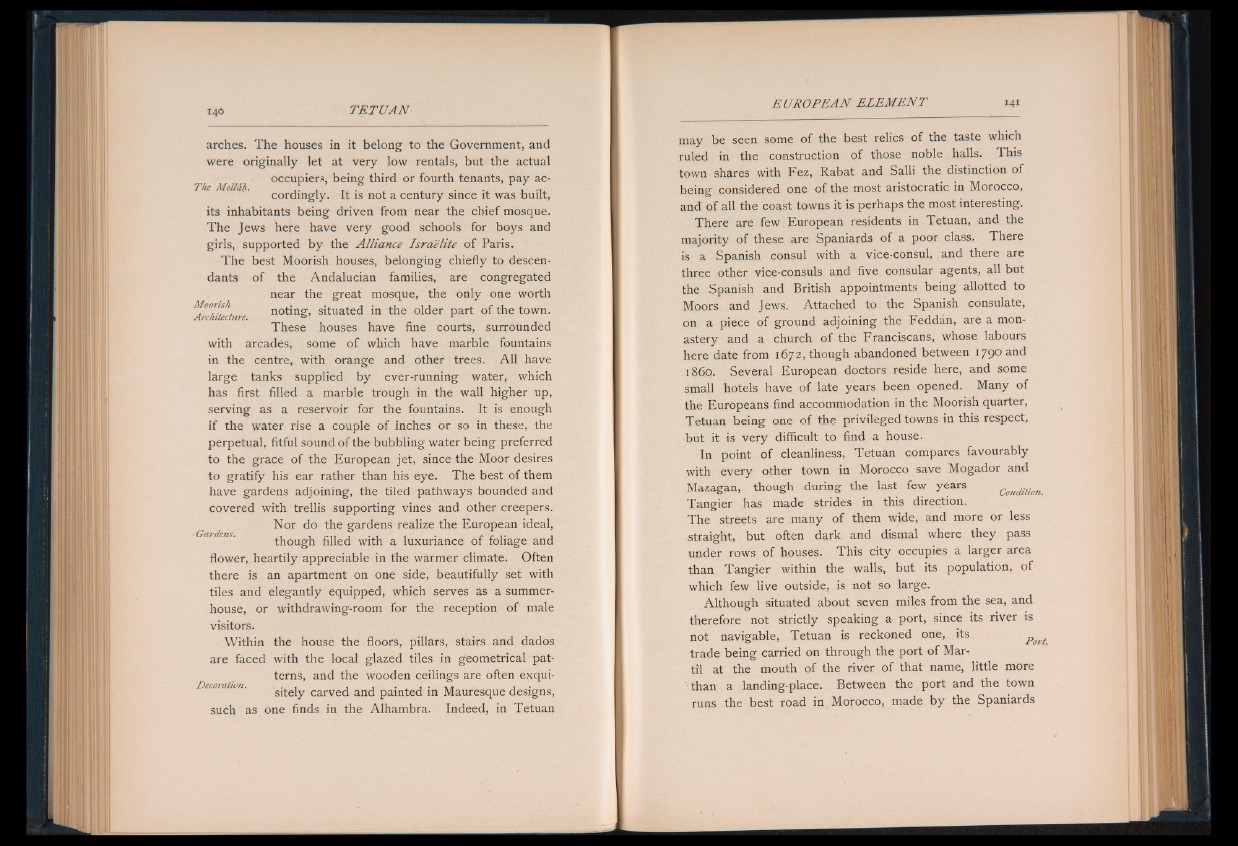
arches. The houses in it belong to the Government, and
were originally let at very low rentals, but the actual
occupiers, being third or fourth tenants, pay ac-
The Melldh. , .
cordingly. It is not a century since it was built,
its inhabitants being driven from near the chief mosque.
The Jews here have very good schools for boys and
girls, supported by the Alliance Israelite of Paris.
The best Moorish houses, belonging chiefly to descendants
o f the Andalucian families, are congregated
near the great mosque, the only one worth
^Architecture noting, situated in the older part of the town.
These houses have fine courts, surrounded
with arcades, some o f which have marble fountains
in the centre, with orange and other trees. All have
large tanks supplied by ever-running water, which
has first filled a marble trough in the wall higher up,
serving as a reservoir for the fountains. It is enough
if the water rise a couple of inches or so in these, the
perpetual, fitful sound o f the bubbling water being preferred
to the grace of the European jet, since the Moor desires
to gratify his ear rather than his eye. The best of them
have gardens adjoining, the tiled pathways bounded and
covered with trellis supporting vines and other creepers.-
Nor do the gardens realize the European ideal,
though filled with a luxuriance of foliage and
flower, heartily appreciable in the warmer climate. Often
there is an apartment on one side, beautifully set with
tiles and elegantly equipped, which serves as a summerhouse,
or withdrawing-room for the reception of male
visitors.
Within the house the floors, pillars, stairs and dados
are faced with the local glazed tiles in geometrical patterns,
and the wooden ceilings are often exquisitely
carved and painted in Mauresque designs,
such as one finds in the Alhambra. Indeed, in Tetuan
EU R O PE AN E LEM EN T 141
may be seen some of the best relics of the taste which
ruled in the construction of those noble halls. This
town shares with Fez, Rabat and Salli the distinction of
being considered one of the most aristocratic in Morocco,
and of all the coast towns it is perhaps the most interesting.
There are few European residents in Tetuan, and the
majority of these are Spaniards of a poor class, There
is a Spanish consul with a vice-consul, and there are
three other vice-consuls and five consular agents, all but
the Spanish and British appointments being allotted to
Moors and Jews. Attached to the Spanish consulate,
on a piece of ground adjoining the Feddan, are a monastery
and a church of the Franciscans, whose labours
here date from 1672, though abandoned between 179° and
i860. Several European doctors reside here, and some
small hotels have of late years been opened. Many of
the Europeans find accommodation in the Moorish quarter,
Tetuan being one of the privileged towns in this respect,
but it is very difficult to find a house.
In point of cleanliness, Tetuan compares favourably
with every other town in Morocco save Mogador and
Mazagan, though during the last few years Condition.
Tangier has made strides in this direction.
The streets are many of them wide, and more or less
straight, but often dark and dismal where they pass
under rows of houses. This city occupies a larger area
than Tangier within the walls, but its population, of
which few live outside, is not so large.
Although situated about seven miles from the sea, and
therefore not strictly speaking a port, since its river is
not navigable, Tetuan is reckoned one, its |g ||
trade being carried on through the port of Mar-
til at the mouth of the river of that name, little more
than a landing-place. Between the port and the town
runs the best road in Morocco, made by the Spaniards